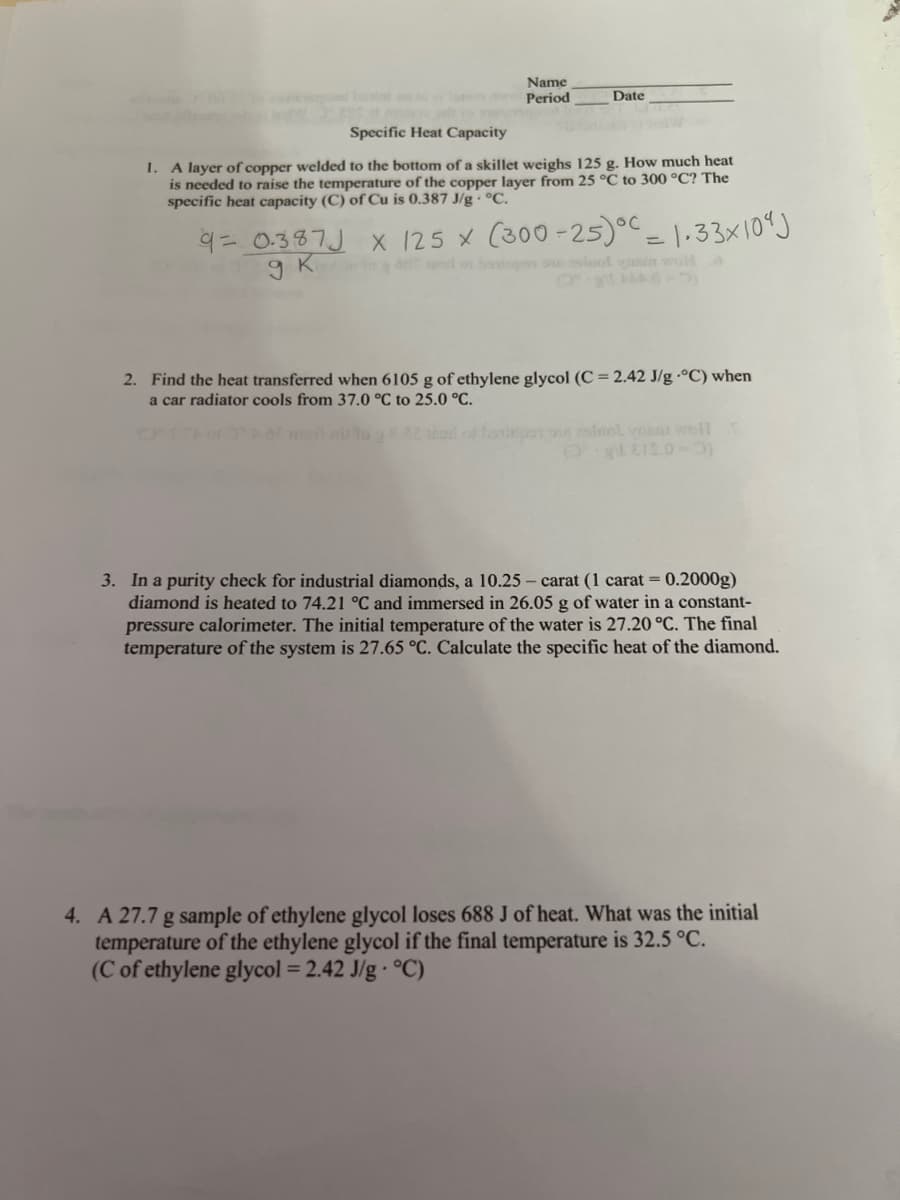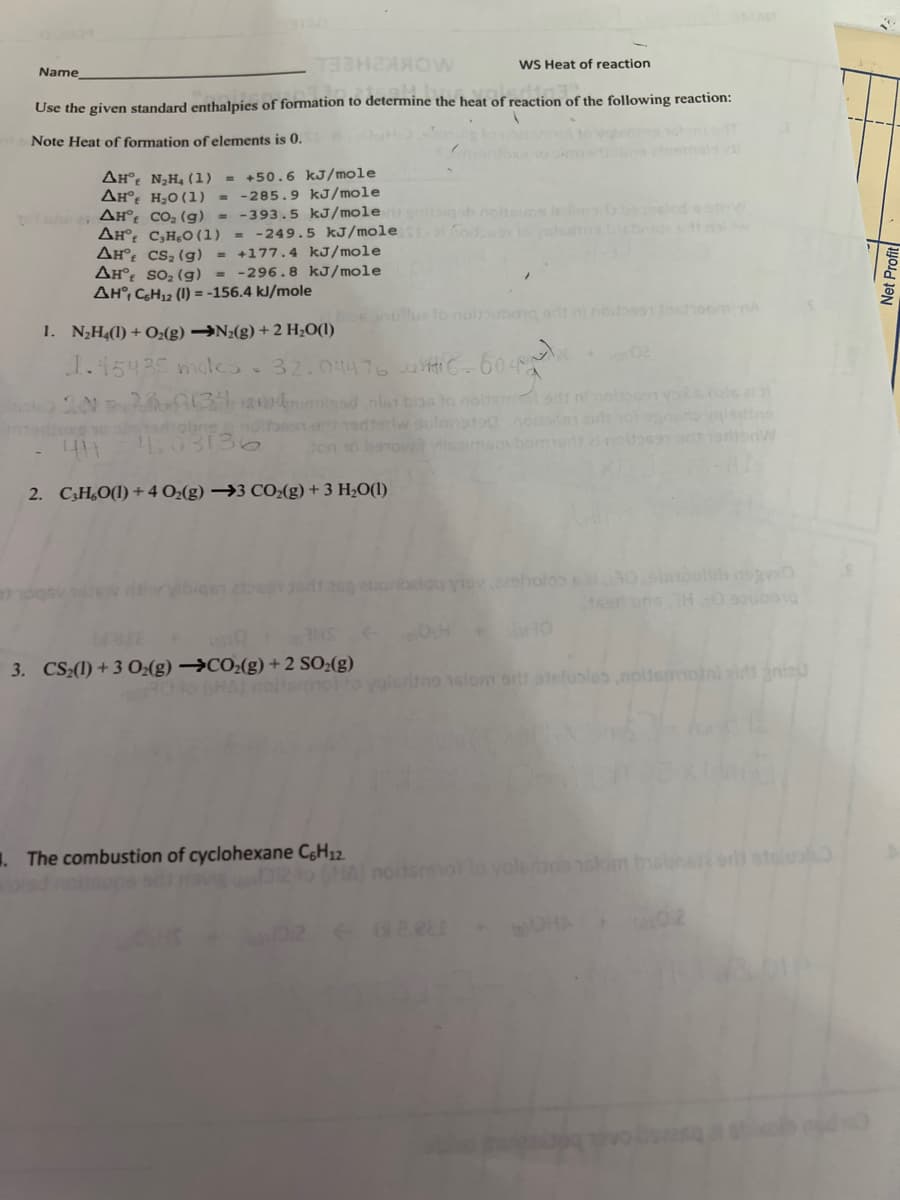Chemistry for Engineering Students
4th Edition
ISBN:9781337398909
Author:Lawrence S. Brown, Tom Holme
Publisher:Lawrence S. Brown, Tom Holme
Chapter9: Energy And Chemistry
Section: Chapter Questions
Problem 9.53PAE: 9.53 Using these reactions, find the standard enthalpy change for the formation of 1 mol of PhO(s)...
Related questions
Question
I need all the answers please

Transcribed Image Text:Name
Period
Date
Specific Heat Capacity
1. A layer of copper welded to the bottom of a skillet weighs 125 g. How much heat
is needed to raise the temperature of the copper layer from 25 °C to 300 °C? The
specific heat capacity (C) of Cu is 0.387 J/g °C.
9= 0.387J x 125 x (300-25)°C = 1.33×104)
9 K
2. Find the heat transferred when 6105 g of ethylene glycol (C = 2.42 J/g °C) when
a car radiator cools from 37.0 °C to 25.0 °C.
à mon noto g 8.82 shod of forispor one zotol you woll
3. In a purity check for industrial diamonds, a 10.25 - carat (1 carat = 0.2000g)
diamond is heated to 74.21 °C and immersed in 26.05 g of water in a constant-
pressure calorimeter. The initial temperature of the water is 27.20 °C. The final
temperature of the system is 27.65 °C. Calculate the specific heat of the diamond.
4. A 27.7 g sample of ethylene glycol loses 688 J of heat. What was the initial
temperature of the ethylene glycol if the final temperature is 32.5 °C.
(C of ethylene glycol = 2.42 J/g °C)

Transcribed Image Text:Name
THROW
WS Heat of reaction
Use the given standard enthalpies of formation to determine the heat of reaction of the following reaction:
Note Heat of formation of elements is 0.
AH N₂H₁ (1) = +50.6 kJ/mole
ΔΗ,
Η,Ο(1) = -285.9 kJ/mole
20he as AH°f
CO₂ (g) = -393.5 kJ/molesnifiqob nohtsupe iema
C₂H₂O (1) = -249.5 kJ/mole-
AH,
AH
CS₂ (g) = +177.4 kJ/mole
AH SO₂ (g) = -296.8 kJ/mole
AH1 CH₂2 (1) = -156.4 kJ/mole
/
1. N₂H₂(1) + O₂(g) →N₂(g) + 2 H₂O(1)
1.45435 maks. 32.04476 HC-604
Xx
20
2291344miga nist biss to not sitt
troline 2 not
4.03136 ton 10 barovelvilsaimen boment
2. C3H₂O(1) +4 O₂(g) →3 CO₂(g) + 3 H₂O(1)
ribelgo visv, 229h
OH
3. CS₂(1) + 3 O₂(g) →→CO₂(g) +2 SO₂(g)
. The combustion of cyclohexane C6H₁2.
slom or pielusies noitemnotni zid nizu
12 to (HA) noitsmhol
Net Profit
Expert Solution
This question has been solved!
Explore an expertly crafted, step-by-step solution for a thorough understanding of key concepts.
This is a popular solution!
Trending now
This is a popular solution!
Step by step
Solved in 3 steps

Knowledge Booster
Learn more about
Need a deep-dive on the concept behind this application? Look no further. Learn more about this topic, chemistry and related others by exploring similar questions and additional content below.Recommended textbooks for you

Chemistry for Engineering Students
Chemistry
ISBN:
9781337398909
Author:
Lawrence S. Brown, Tom Holme
Publisher:
Cengage Learning

Chemistry: An Atoms First Approach
Chemistry
ISBN:
9781305079243
Author:
Steven S. Zumdahl, Susan A. Zumdahl
Publisher:
Cengage Learning

EBK A SMALL SCALE APPROACH TO ORGANIC L
Chemistry
ISBN:
9781305446021
Author:
Lampman
Publisher:
CENGAGE LEARNING - CONSIGNMENT

Chemistry for Engineering Students
Chemistry
ISBN:
9781337398909
Author:
Lawrence S. Brown, Tom Holme
Publisher:
Cengage Learning

Chemistry: An Atoms First Approach
Chemistry
ISBN:
9781305079243
Author:
Steven S. Zumdahl, Susan A. Zumdahl
Publisher:
Cengage Learning

EBK A SMALL SCALE APPROACH TO ORGANIC L
Chemistry
ISBN:
9781305446021
Author:
Lampman
Publisher:
CENGAGE LEARNING - CONSIGNMENT


Chemistry
Chemistry
ISBN:
9781305957404
Author:
Steven S. Zumdahl, Susan A. Zumdahl, Donald J. DeCoste
Publisher:
Cengage Learning

World of Chemistry
Chemistry
ISBN:
9780618562763
Author:
Steven S. Zumdahl
Publisher:
Houghton Mifflin College Div